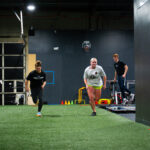Speed and Agility Training for Basketball Players
Basketball is a game of quick bursts, sudden stops, and constant direction changes. That’s why speed and agility training is crucial for basketball players at every level. It sharpens your footwork, increases reaction time, and gives you the edge over your opponents.
Why Speed and Agility Training Matters in Basketball
Basketball demands more than just speed. Players need to be quick, balanced, and responsive. Speed and agility training enhances all these elements.
From cutting through defenders to recovering on defense, quick footwork makes the difference. Agility drills also strengthen joints and muscles, helping prevent common injuries like ankle sprains and knee strains.
Key Benefits for Basketball Players
Speed and agility training delivers performance improvements where they matter most. Here’s how it helps:
1. Explosive First Steps
Quick acceleration allows you to drive past defenders or close gaps on defense. Drills that focus on explosive starts build this ability.
2. Rapid Direction Changes
Changing directions efficiently helps players shake defenders and stay in front of offensive threats.
3. Enhanced Balance and Core Strength
Basketball footwork relies on core control. Agility work strengthens the muscles that keep you centered and upright.
4. Better Court Awareness
Quick movements and reaction drills improve hand-eye coordination and spatial awareness, making you more effective under pressure.
Essential Drills for Basketball Agility and Speed
Training should simulate real-game conditions. These drills are basketball-specific and highly effective:
Zig-Zag Cone Drill
Place cones in a zig-zag pattern across the court. Sprint and cut between them, focusing on sharp turns and quick recovery.
Defensive Slides
Work on lateral speed with shuffle drills across the key. Stay low and controlled to mimic in-game defense.
3-Point Line Suicides
Run from baseline to free-throw line, half-court, and 3-point line. This builds endurance and explosive court speed.
Lateral Band Walks
Use resistance bands to build hip strength. This increases lateral stability and helps prevent knee injuries.
Check out NSCA’s basketball-specific training guide for more advanced drills and tips.
Weekly Training Plan for Basketball Players
Here’s a sample schedule to follow:
-
Monday: Zig-zag drills + resistance work
-
Wednesday: Defensive slides + lateral band walks
-
Friday: Court suicides + core strengthening
-
Saturday (Optional): Game-speed scrimmage with agility focus
Always warm up before each session and stretch afterward. Recovery is key for consistent improvement.
Common Mistakes to Avoid
To get the most out of your training, avoid these common pitfalls:
-
Skipping warm-ups or cool-downs
-
Doing drills too quickly with poor form
-
Training only straight-line speed
-
Ignoring rest and recovery
Basketball movement is multi-directional. So your training should match that demand.
Integrating Speed and Agility Training into Practice
You don’t need a separate session for speed and agility training. Blend drills into your practice routine. For example:
-
Use zig-zag runs as a warm-up
-
Add foot-speed ladders between shooting drills
-
Start scrimmages with fast-paced agility rounds
At Next Level Athletics USA, trainers often use this integrated approach to maximize training time and results.
Strength and Mobility Matter Too
To really level up, pair agility work with strength and mobility training. Exercises like squats, lunges, and planks build the foundation that allows speed to flourish.
Additionally, mobility drills keep joints flexible and resilient—critical for high-impact sports like basketball.
Final Thoughts
Speed and agility training helps basketball players play faster, smarter, and safer. It builds the quickness and control needed to make game-changing plays.
Train consistently, keep your movements sharp, and focus on realistic, sport-specific drills. With time, you’ll see a real difference in how you move on the court.


Recent Comments